It’s time… for me (Winter) to take you (whoever you are) on a trip down the process Windy & Wallflower takes to develop a comic book from START to END.
FEATURING: AUGUSTINE VOLUME 1
So where the hell do we even start? Comic making itself is such a daunting task. For most of our comics, one of us makes an original character, and then the other one of us makes another original character to go WITH that guy, we ship them, the story starts to build itself. We’re both character-based writers so a lot of our stories’s plots circle around a particular type of character relationship and conflict, and then we go from there.
AUGUSTINE… is different.
Tas has been doodling concepts for a Harpy x Human story since we met and we put their love of Bird People and my love of Greek Mythology fused into a story we originally called: XENIA (if you’ve been perusing my website you might notice this title is still floating around hehehe). The thing with this original version of the story is that it felt a bit Too Serious for the fun we really wanted to have with it.
Serious is definitely not a BAD thing but we knew this project was essentially going to be our next Webcomic so we needed something that would be more fun and filled with Antics. We were also getting lost in major Plot Elements and losing track of some of the character moments we really wanted to sink our teeth into.
So we started into the FIRST STEP into making this series OFFICIAL…
BRAINSTORMING
Okay so now’s where we’re usually cooking. Brainstorming for the two of us cultivates in a myriad of ways, depending on the project. For AUGUSTINE we’d come to the decision we wanted a bit more of a zainy cast of characters, a bit along the lines of the action-packed & dry humour of MAD MAX or BORDERLANDS. We figured out Aesthetics for this world pretty quick and though we don’t have a Mood Board to show you because we just both got on the same page real fast…
We both certainly went through several iterations of a playlist (this what it sounds like now though fair warning we’re always picking).
But once we have the Groundwork Sorted, this is when we start ‘playing in the playground’ so to speak (generally it’s when I start throwing random questions at Tas just to get their POV on different character aspects & find out if we’re on the same page).
So I’ll ask things like:
- what sort of hobbies do these kids have?
- have any or all of them dated before?
- have they all dated each other at all?
- who is the most to least responsible of the group?
- how was the group formed/who started it and when?
- how old was each one when they got there?
- what kind of family life & upbringing did they have?
- whats their motive/incentive/driving force?
- what kind of attitude do they have on the world?
- what kind of religious/superstitious beliefs do they have?
There’s RANGE here, anything from silly to potentially plot-relevant. The silly ones help me really get an idea of what Jokes we want to play up with different characters. What their relationships with one another is like. What are their Limits for patience and understanding. ETC.
Listen, you never know when you might need to know a character’s Favourite Colour, that COULD end up being plot-relevant or just help with some character’s flavour text later!! And while questions like, ‘what would Heti’s tumblr blog look like?’ might not make it into CANON, it sure does highlight certain parts of their personality and fleshes them out as a character!! It’s silly but it works!
A lot of the Actual Answers to these aren’t going to make it necessarily into AUGUSTINE but it helps me with the writing part after the fact, it makes it easier for us to be on the same page and really grasp them.
BTW: I love when people ask us funny & oddly specific questions about characters from our comics because even IF neither of us has an answer for you at the time, it’s certainly something that noodles around in my brain and could potentially help round out someone’s arc, even if the question seems really simple!
These types of gag-questions also helped us with a lot of the funnies we built for AUGUSTEENIES because this group is so silly to me, it was hard to omit some of their antics and streamline things down for the main comic we actually wanted to build.
One last IMPORTANT and notable detail in this project’s brainstorm process is we had an EDITOR (Gisele) who asked their own very important an pertinent questions to help flesh out AUGUSTINE from the get-go. (You might recognise Gisele’s work, they create: STARLIGHT & BRIMSTONE and STAR TRIP).
For the record: BRAINSTORMING is also where we do a lot of development art (admittedly, mostly Tas). Here’s some of the stuff he was cooking up as we were trying to figure out the Vibe of AUGUSTINE/XENIA.
Okay so we brainstormed… now what?
OUTLINING
Oh… I hate this part haha. I think of everything this is the most tooth-pulling part of the story writing process. I’m the kind of guy who likes to jump right into a story and pants (as in ‘flying by the seat of my’ and not ‘pulling them down’) it all the way through a first draft. It lets me be flexible and feel out where a story is going and make split-second decisions that may or may not have more interesting outcomes.
BUT you can’t really DO that when you’re working in a TEAM.
So we take a fresh doc and we look over our notes, art, and chit chat during the brainstorming stage, and we try to piece the puzzle together as to how this makes a story. This part usually gets a bit heated because the two of us are very passionate about the stories we make and this is where and when most of our disagreements happen, BECAUSE this is where the final lines in the sand are drawn. Alas!
This is also when our awesome editor pipes in and sticks their fingers in the holes of our outline we didn’t even know existed. We pick and we fine-tune until it’s decent (enough) for me to start on my FAVOURITE part…
SCRIPTING
So. Scripting is MY job for the most part. And I LOVE this part, which is why while BOTH of us are capable and have scripted comics before. It’s been placed delicately in my hands. Tas trusts me a lot with this but even when I’m drafting it, I’m going over scene twists and turns with them before I jump in. I also usually hand it over for her to read (eagerly) and get the big thumbs up.
ALLEGEDLY there is some sort of MAGIC to getting to read a script as it’s being written but what do I know, I’m just the guy who writes it.
I’m extremely flexible at this stage. Where once, my writer’s pride would and could have been wounded by an outside force asking the (WRONG) questions, now it’s just a piece of the process. Tas and I talk over what’s working, and/or if something isn’t working. This is the best and easiest time to make fixes so it’s better to be flexible here than realise, ‘oops, I’ve got to fix this’ later when it’s sketched/inked/coloured.
The only thing that isn’t entirely set in stone here is the dialogue which pretty much gets fixed and poked at right up until we send to print.
Anyway, here’s a few examples of my script from AUGUSTINE chapter 1 (pages 55-59. I’ll be using these pages throughout as the same example so you can see how the story shifts with each step).




I also do not script using a traditional comics script (hiss–there’s just too much structure and convoluted nonsense to it). I use a ‘screenplay’ style which generally means a script intended for TV/movies without all the camera direction and then I split that script up into pages once the ideas are all down in a first draft. Maybe this is ass-backwards to some, but since both of us are illustrators it feels weird to describe things panel by panel since we live together and I can explain MY VISION to my partner who lives with me. I… also like to give Tas as much leeway as I can with the art.
Besides … I also do the thumbnails.
THUMBNAILING
So I’m pretty sure some of you reading this MIGHT already know what a ‘thumbnail’ is but in case you don’t, these are small compositional drawings that allow artists to lay out panels, bubbles and sketch small versions of scenes. Putting pages and actions and bubbles down on a tiny scale lets you assess how the story is flowing and progressing without having to rework big pages.
At least that’s what most people use them for. I’m a little bit Cursed when it comes to thumbnailing I really do NOT give Tas a lot to work off of admittedly (I’m SORT OF getting better with time… these AUGUSTINE Thumbnails are uhm… more involved than the ones I used to give Tas for Paint The Town Red… HAHA;;;
Maybe I’ll make a couple PTTR posts showing off that process too because woof Tas is made of magic transforming my thumbs into the sketches he produces.
ANYWAY. This is what some of my thumbnails looked like for Augustine Chapter 1
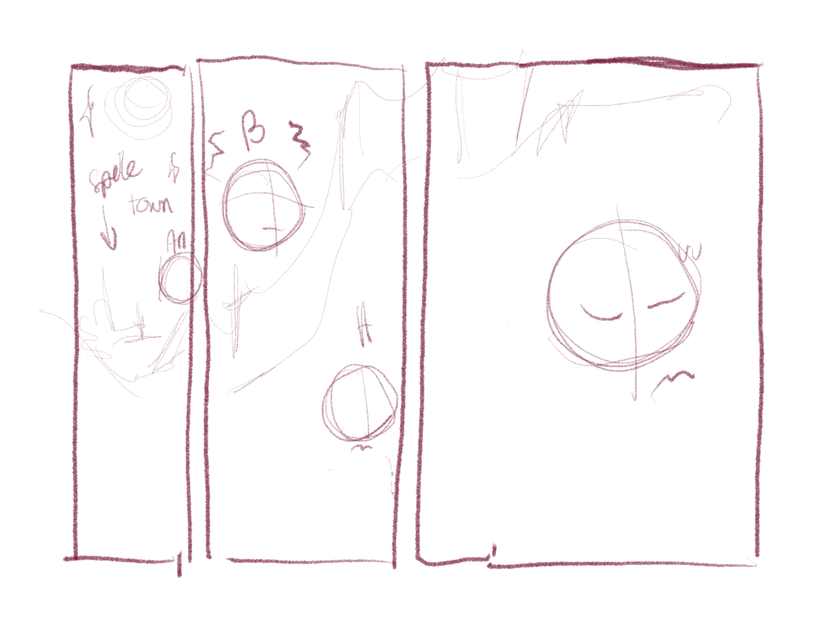
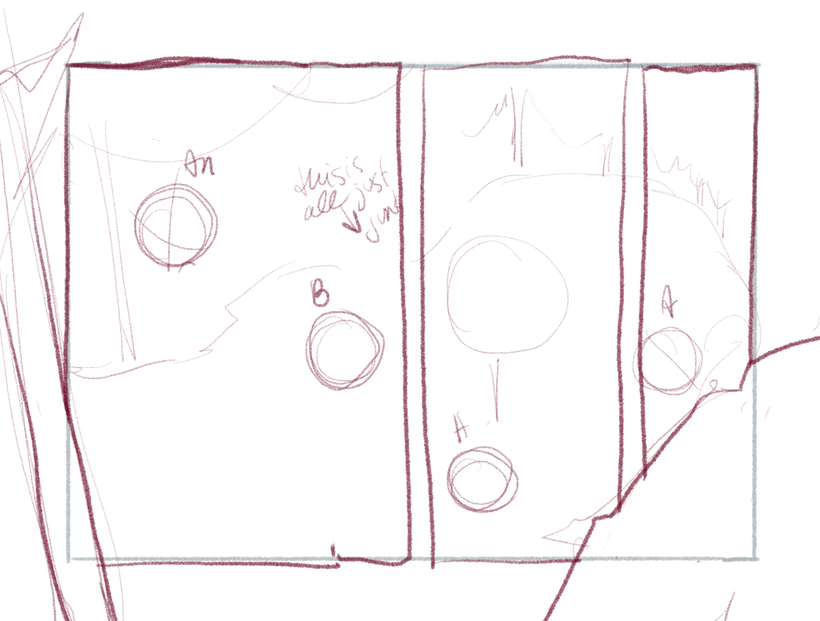
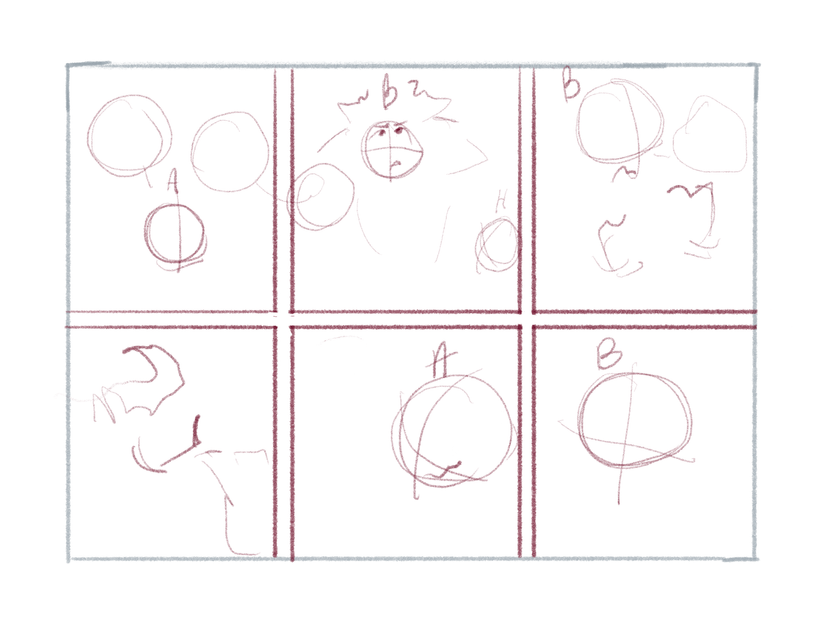
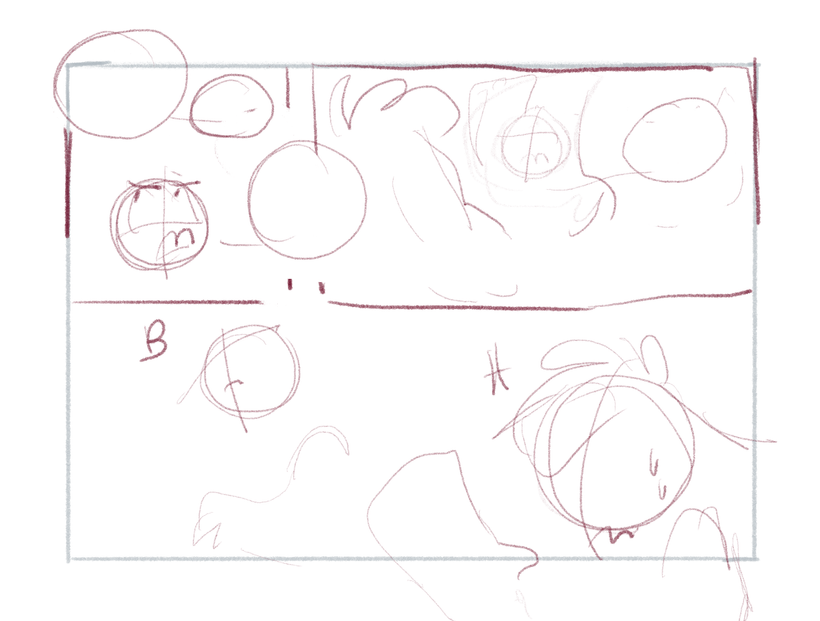
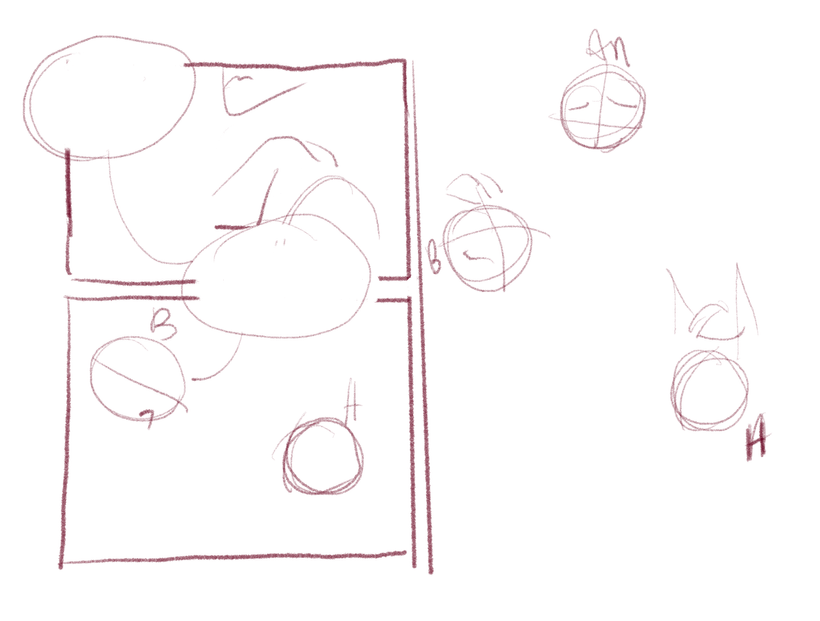
My process here is to mostly keep panel arrangements interesting and flowing with the movement of the page while not distracting too much from the line of action. Admittedly Tas was pretty leery when I said I wanted to make AUGUSTINE in a landscape format. It doesn’t work super well with the ~mobile~ platforms online but a landscape page does fit a computer/desktop screen much better than vertical pages. I felt like I could push my panelling a lot more in a different format than if I just went for a portrait style. Plus it’s a desert… that shit is long and sprawling you need big long wide pages to play that up hehe.
Things get pretty straightforward from here on out…
SKETCHING
This is where Tas steps in to save the day and do the part I dislike (mostly from a confidence standpoint). She somehow takes my scraggly little thumbnails and turns them into this:
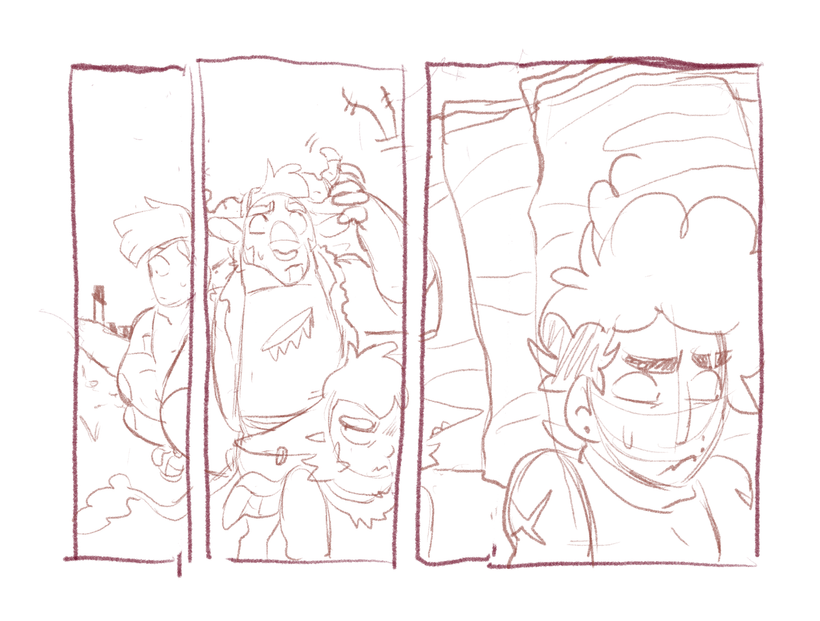
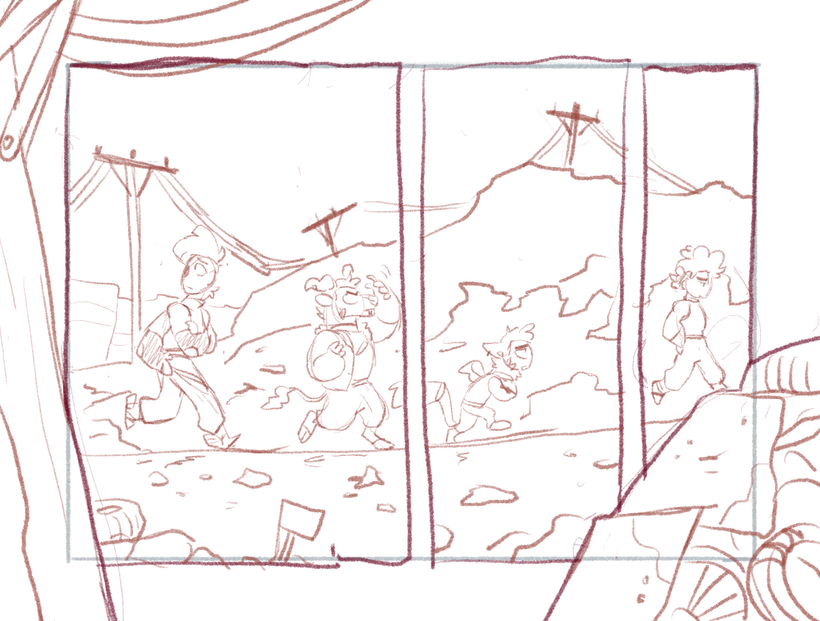
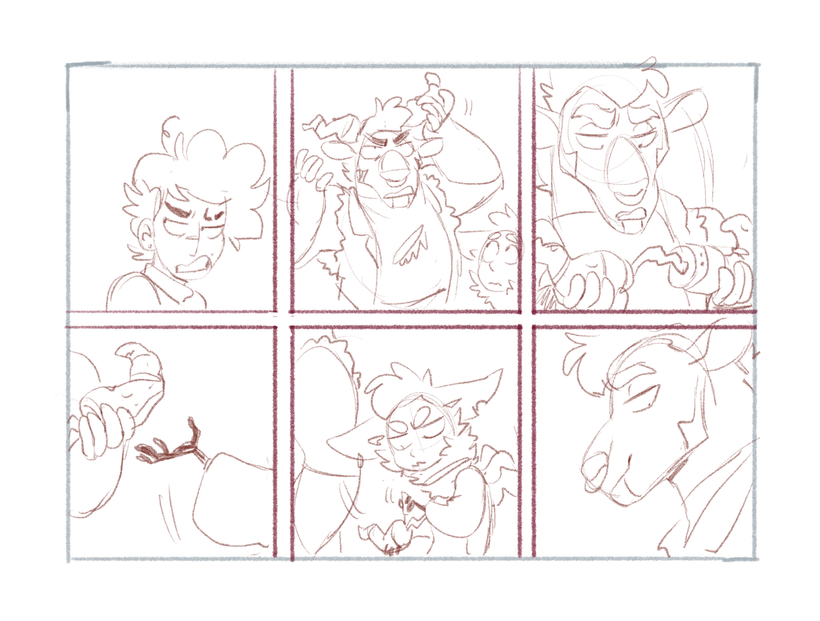
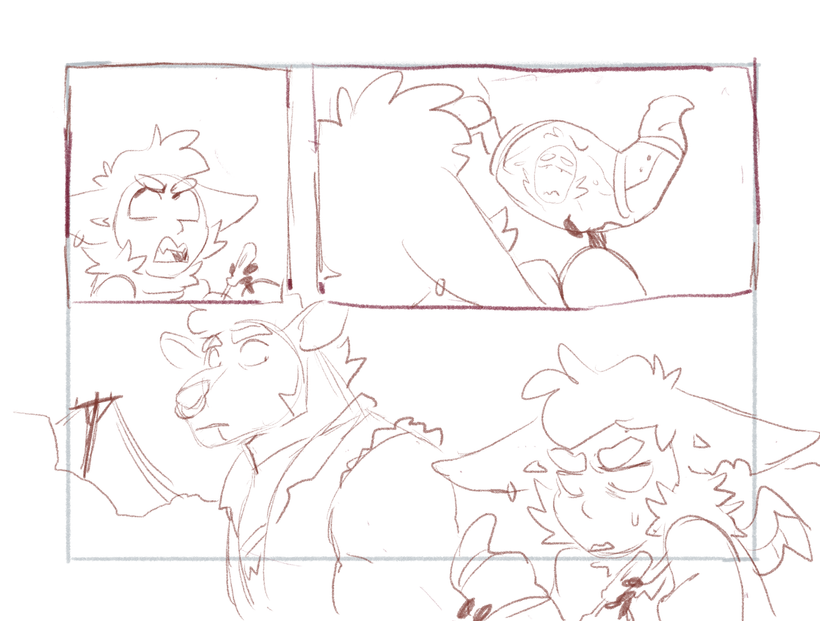
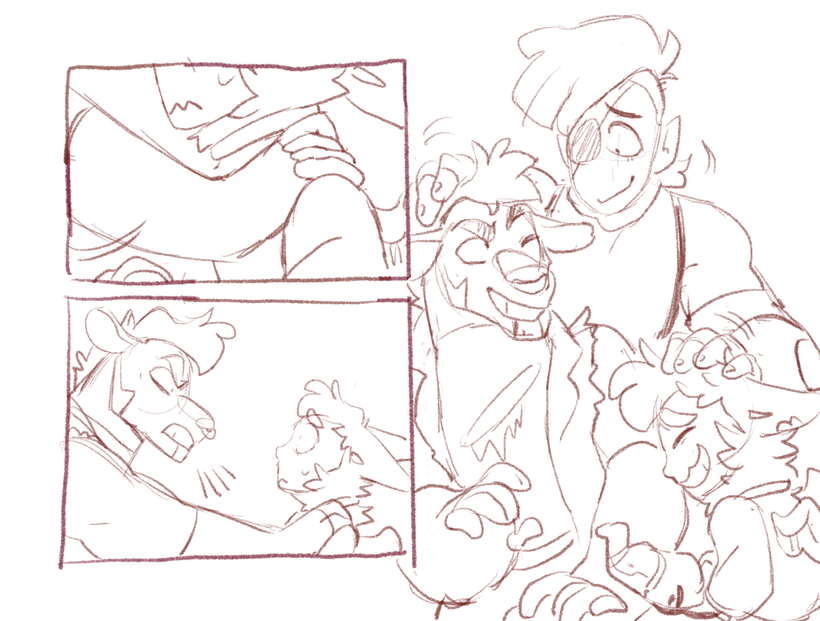
Insane right? I explain the best I can often in person what the thumbnails are trying to do and they deliver (often in ways I might not have been able to personally). That’s what 10-15 years of comics making experience does to a guy. Hehe.
We’ve also shifted a bit of our process recently since I’m hand-drawing the bubbles for Augustine, Tas will finish their sketch and then place the text on a floating layer where the bubbles should go. It’ll look kind of like this:
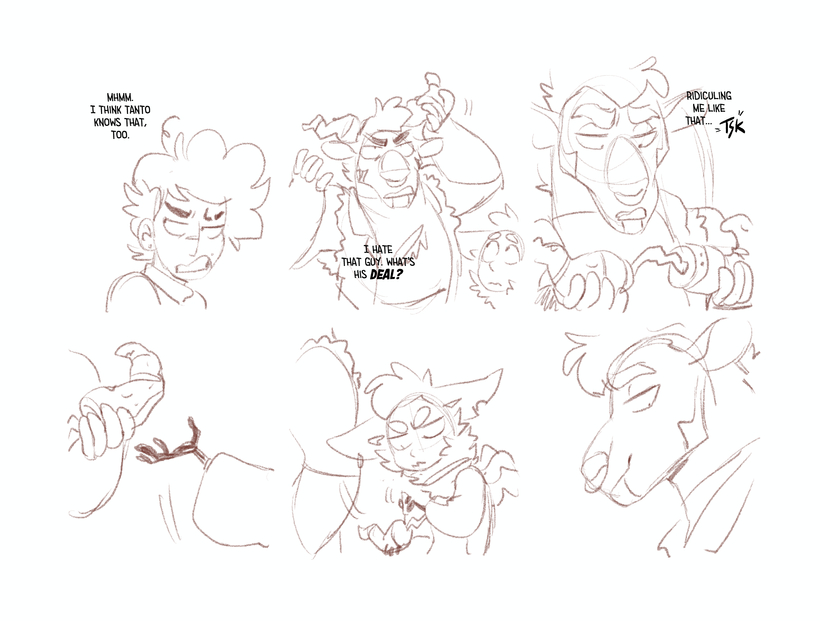
(This would still have the panels i just delete the panel layer when I ink pages and we don’t have this example to show otherwise woops!)
We also started realising how much easier it makes things on me to ink when I have a bit more context to what the characters are saying. I have a rough idea since I did write the script BUT usually by the time I’m inking this we’re weeks if not MONTHS from when I originally wrote it so I was having to decipher context from sketches can be a bit tricky.
INKING
Aaaaaand that’s me again~! Tas tosses the pages back to me and I make them look like this:
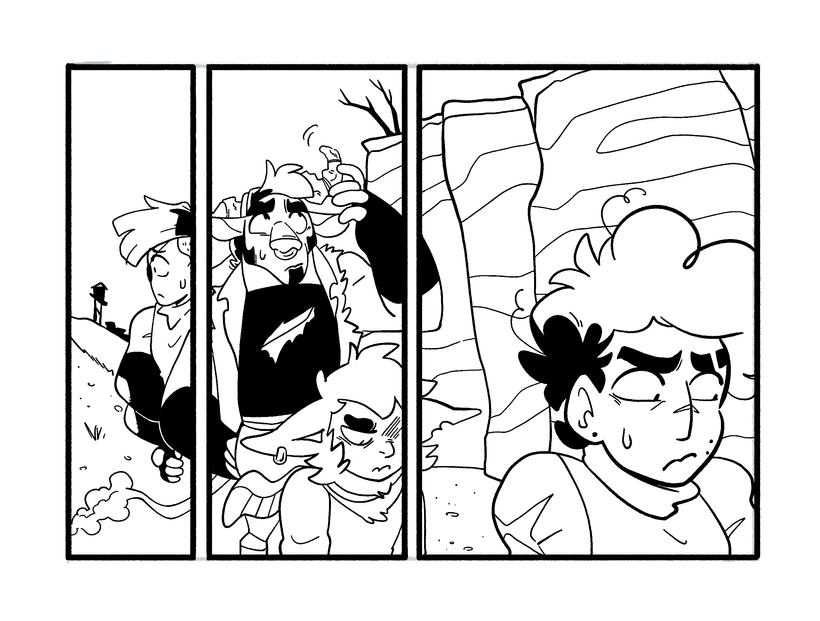
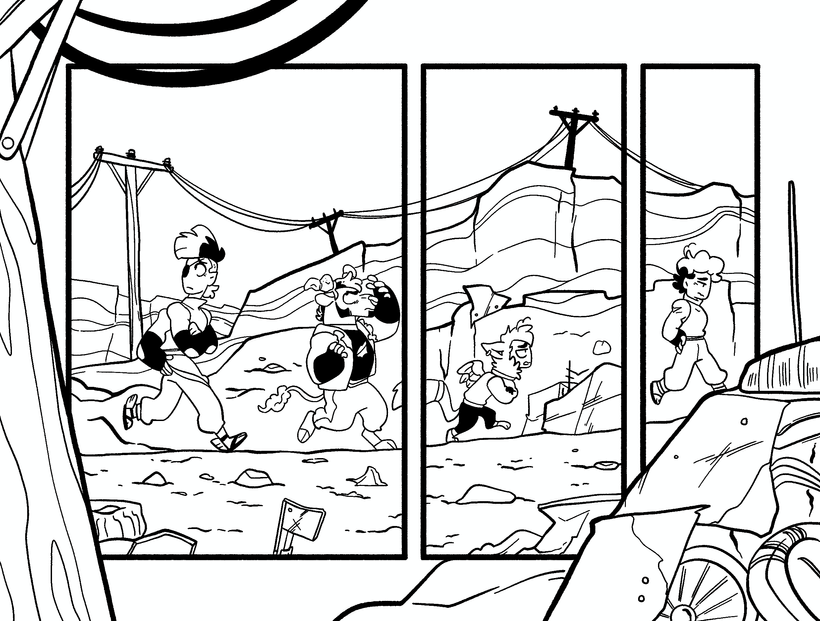

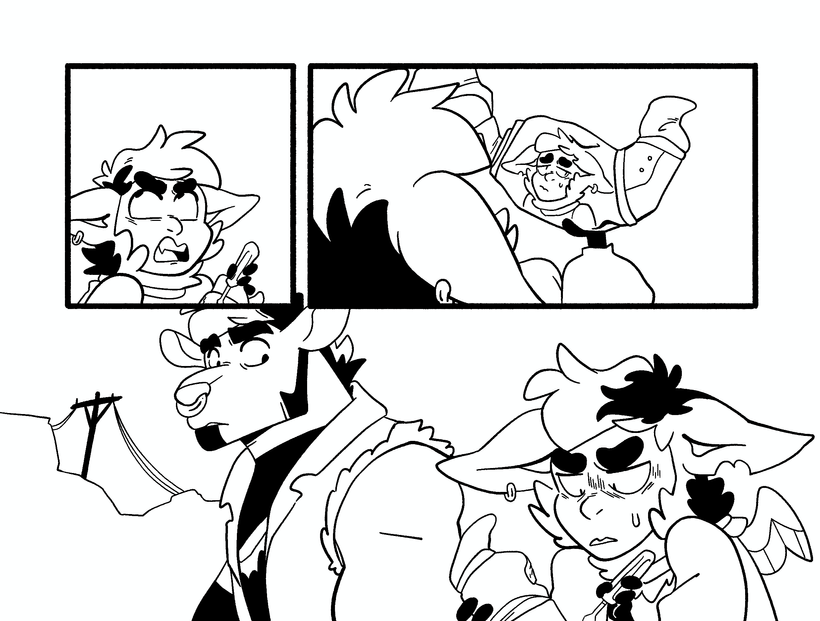
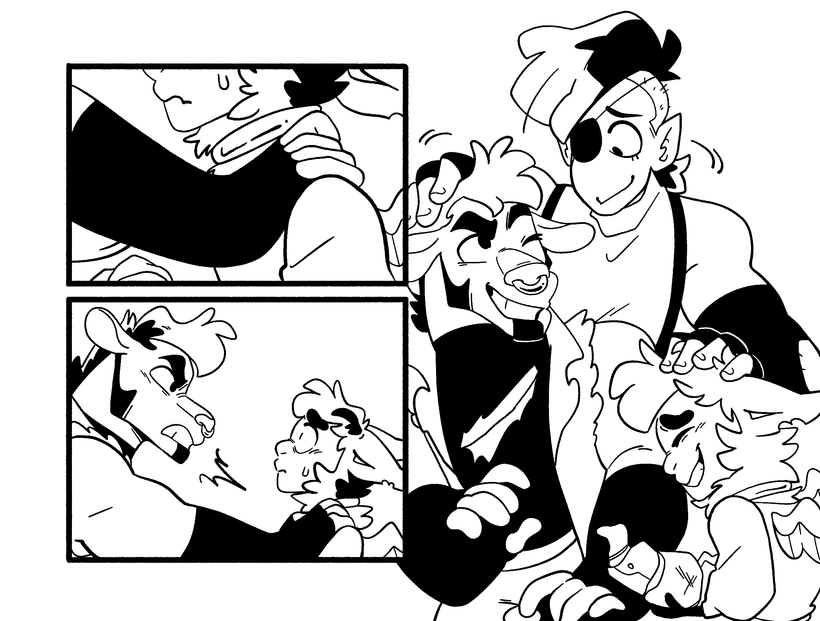
As you can see…. not MUCH changes. I refine the sketches as I ink to keep the characters on model and make sure everyone’s scars and such are all kept uniform.
While scripting is my favourite part of the process, INKING is a close second, I’ve been told I’m a bit of a freak for it.
At the end of each page I also add in the bubbles with a transparent colour layer so that Tas can do her magic and give them an outline in the colouring stage.
What I give them looks like this:
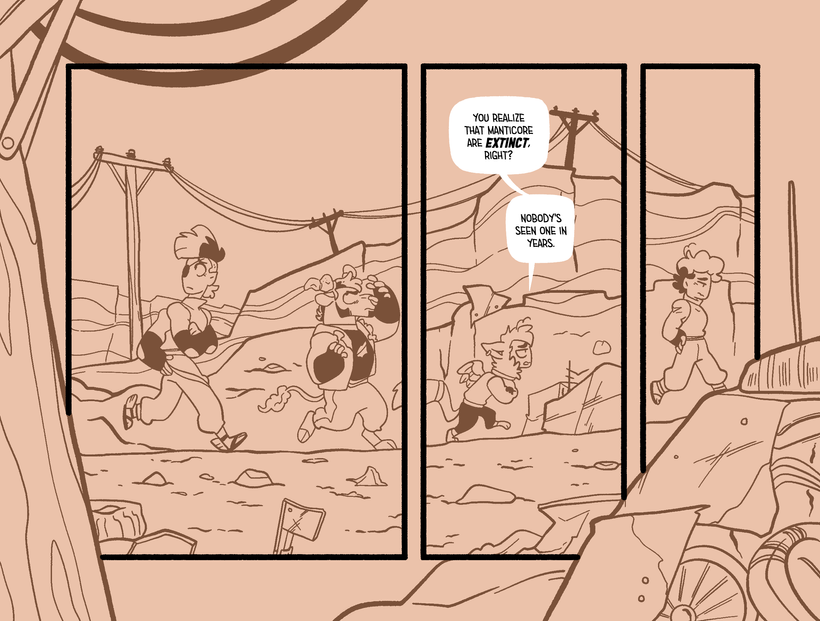
And that’s it! Next is colouring~
COLOURING
And nearly-last but certainly not least, Tas puts all the wonderful colours on these bad boys (I’ve been told that’s her favourite part) and finalises them with all the bells and whistles and bubbles.
So they look like so:
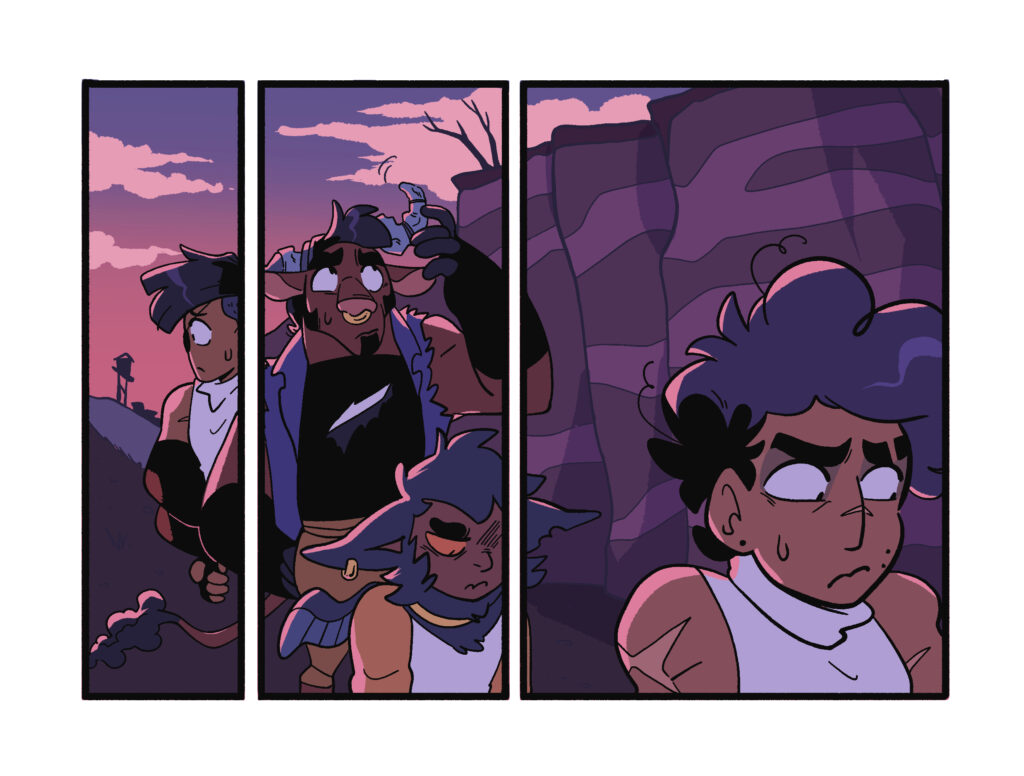
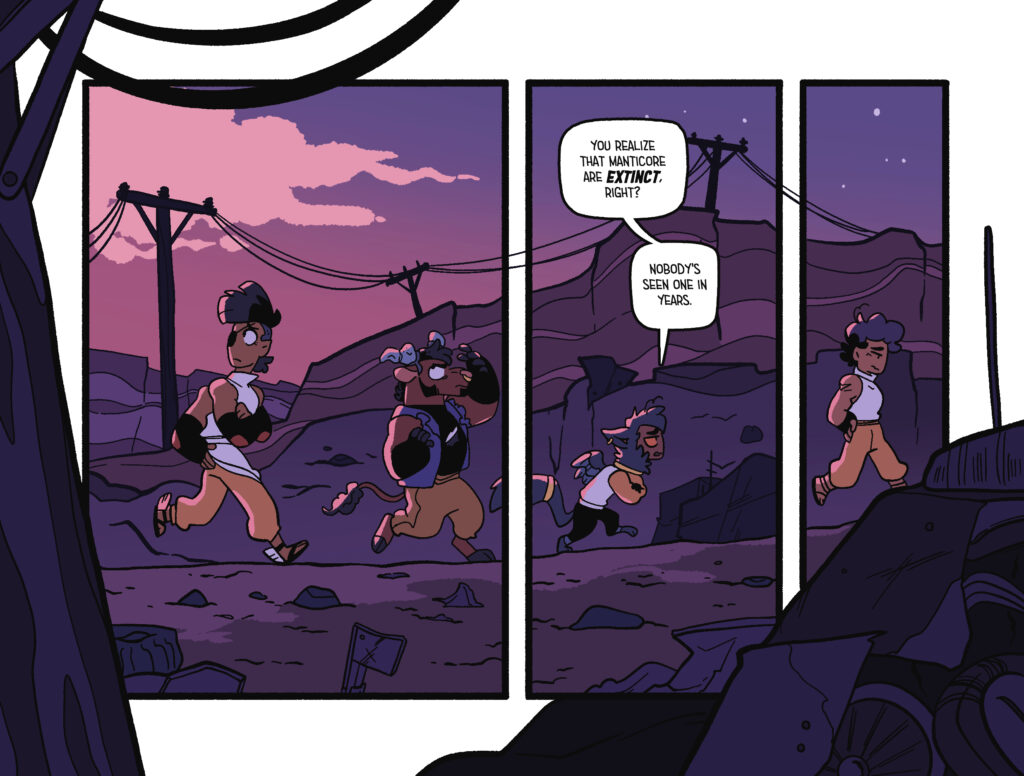
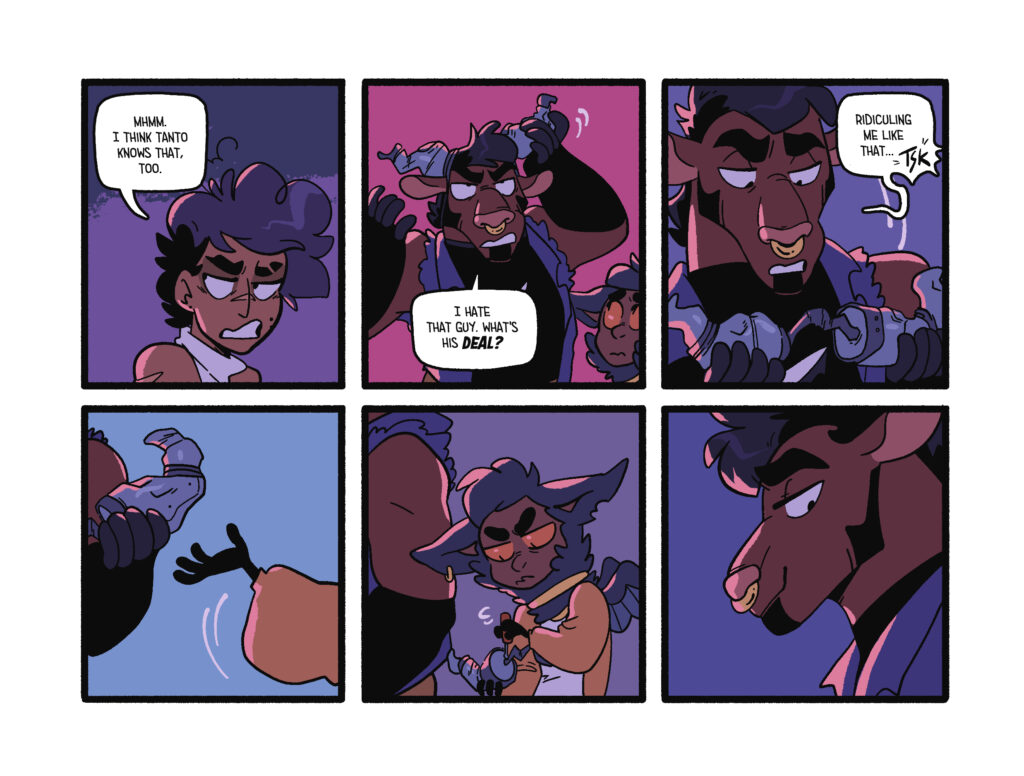
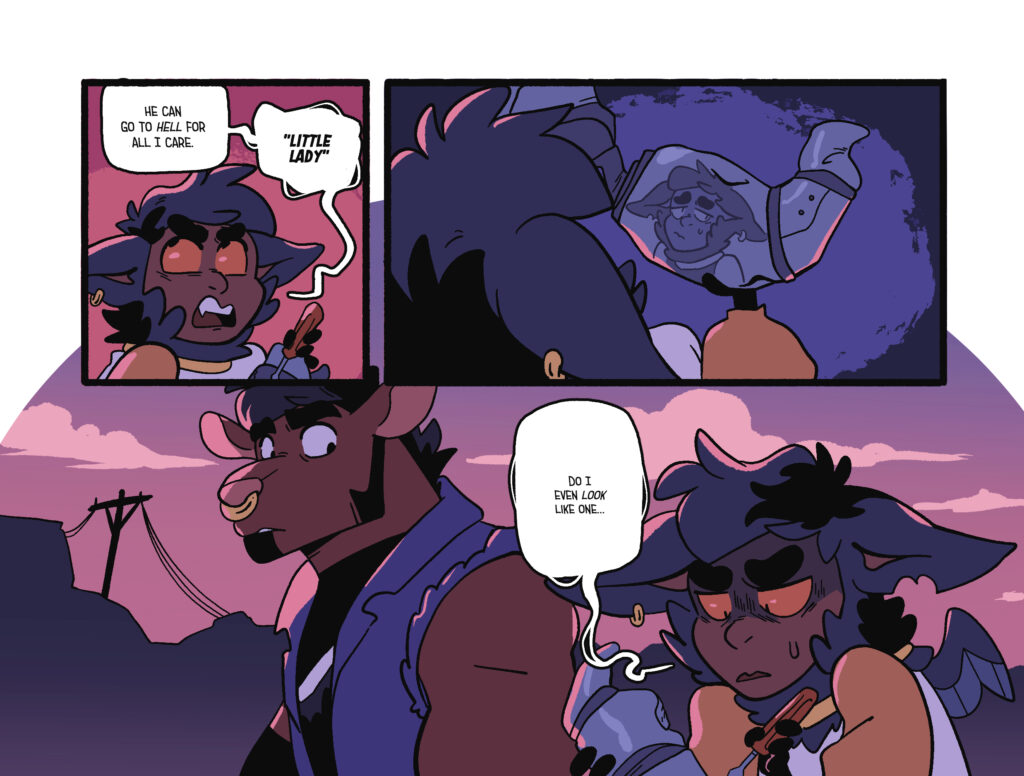
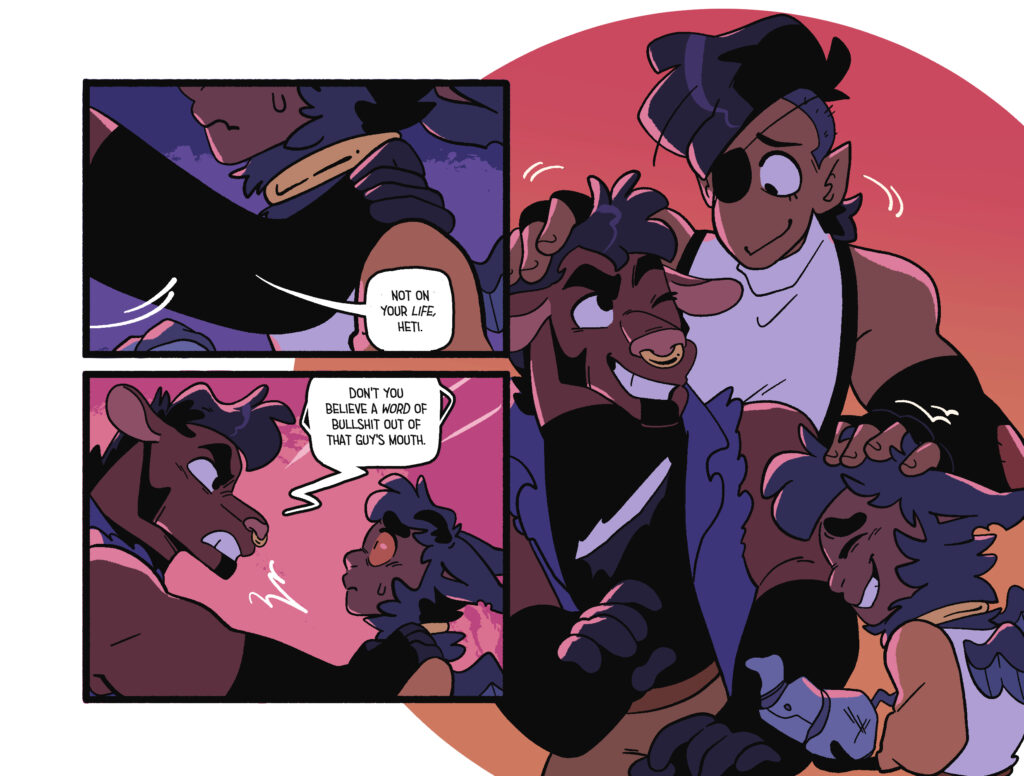
Phew~! What a process! Working this way seems a bit chaotic but it means we’re both working and producing for parts the other one either dislikes or isn’t the most fond of all the while getting to do the parts we enjoy! It also means we get to split the heavy duty work on two shoulders instead of one. IE: Sketching and Inking are both extremely strenuous on an artist’s hand so splitting those two steps helps. Thumbnailing and Colouring also require their own strain which is nice getting to split up as well.
Okay, so what about… lettering…? That’s a part of the process too.
LETTERING
So, lettering in our case is split into 2 categories: onomatopoeia and speech bubble text. Tas takes care of the latter in the sketching phase and loosely places the text in word-bubble shapes in the areas I circled in my thumbnails (and/or/more often makes a GUESS at where the text should be because I’m evil).
I take care of the former (SFX) on a separate layer in the comic during the inking phase. I also take a second when I’m finished inking to lay down a transparent colour layer and I build speech bubbles just by drawing them out (I make a lineless bubble in white) and Tas adds the outline in the colouring phase.
This seems, maybe absolutely contrived but it’s just a funny little workflow that developed through AUGUSTINE because the two of us weren’t happy with Clip Studio’s bubble making ordeal. It felt a bit too computerized against the more rough-and-tumble look of the comic & Tas had to keep fighting it to get the right vibe. Turns out this is easier wowee!
No gallery for this section because you can see, above (or if you continue below), what the final pages look like!
WOW IT’S A COMIC!
Let’s take a look at this thing side by side with the pages we’ve been working with:
PAGE 55





PAGE 56





PAGE 57





PAGE 58





PAGE 59





I’ve never really put these side by side but it looks pretty cool! So um… what now? You have a comic? What do you do with it?
Honestly, you congratulate yourself first because this is a LOT of work! Great Job! You can honestly stop here but for folks who want to KEEP GOING (like us, we love to share our work with people) then here’s our breakdown…
FORMATTING
Then comes the joyous task of formatting pages for online use! From what I can tell (and Tas can correct me on this) we don’t change much, we just upload the files we have to our website, schedule those and then schedule the social media posts to remind. Tas usually does the website shenanigans. We split our efforts on social media posts…. when we remember to do them.
PRINTING
Now, if you want to PRINT the comic, that’s a whole other ball of wax. Our formatting for printing usually happens in 2 stages for us. Tas does a whole BUNCH of colour adjustments to get the colours to read as close as possible to what’s on the screen (they’re a fuckin wizard at it) and then they toss those pages to ME who gets the joy of putting it all together in Affinity Publisher before slapping it on over to our printer.
This part is extremely tedious and a whole other type of post so I’ll leave it here for now and then maybe one day find myself brave enough to explain our process and post it up here on our website.
Full layout pages look like this:
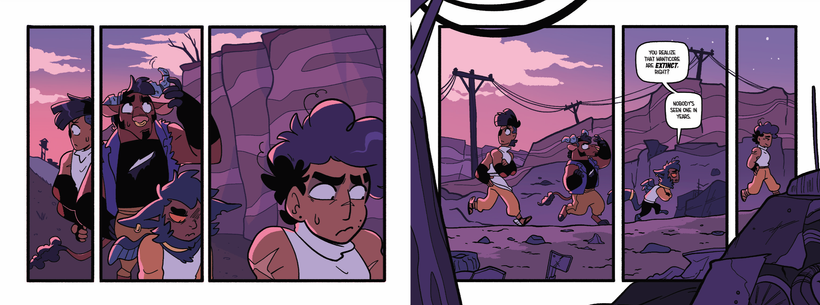
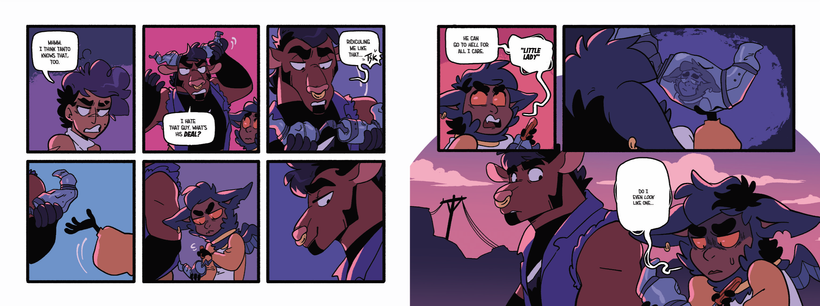
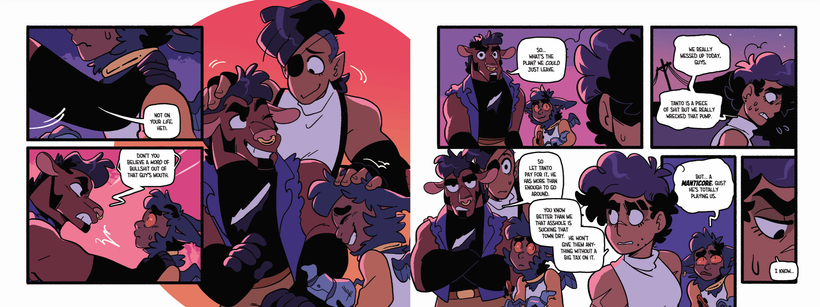
I DO plan these layouts out in the thumbnailing stage, which pages will line up next to each other, you’ll notice in the script 55-56 is labelled like a spread because the framing of these panels works best next to one another. For me, all our stories “Final Look/Product” is thought up in the brainstorming stage so that I know how to thumbnail & what size to work at.
REMEMBER IF YOU’RE PRINTING OR EVEN THINKING OF PRINTING PLS WORK AT 300 DPI!!! MINIMUMMM!!
You’ll thank me later.
Anyway then we take this big heckin PDF file and post it on our SHOP and/or send it over to our printer!! And then she shows up in a BOX on our DOORSTEP and it’s a wild and magical ride!
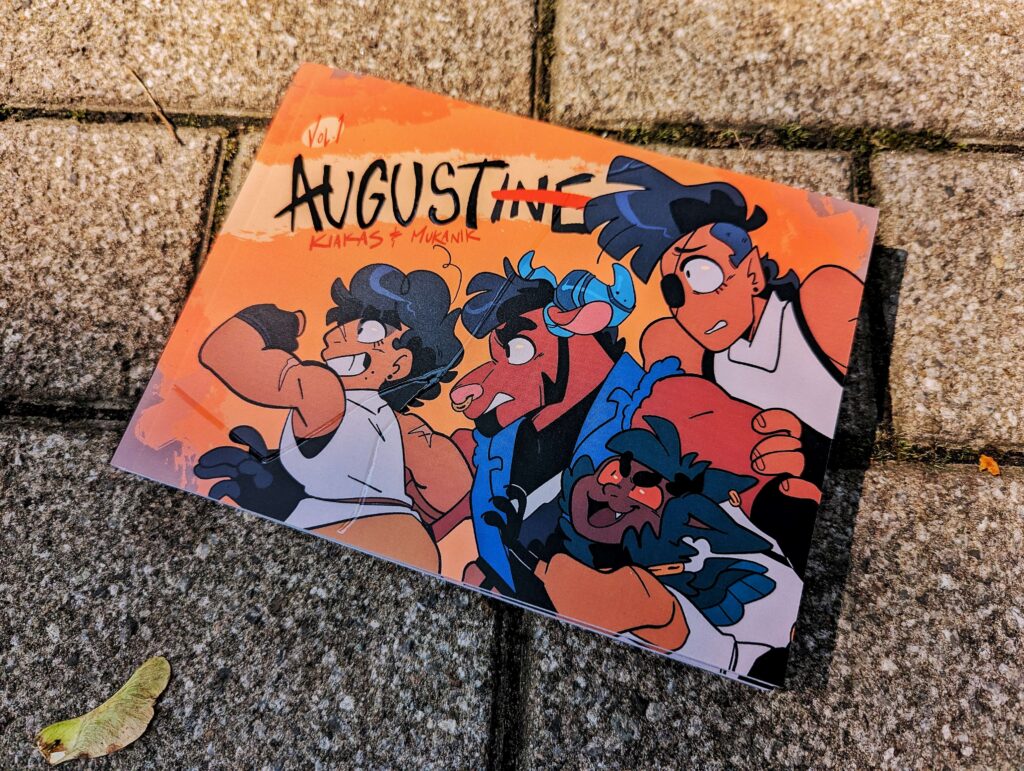
As you can see… a LOT of work and that’s just for a 72-page chapter for one of our stories! We put a lot of love into these bad boys. I hope it shows ;v;/
Thank you all for reading AUGUSTINE and if this is the first time you’re hearing about the comic, don’t forget to catch up! We’re almost at a whole whopping 200 pages!
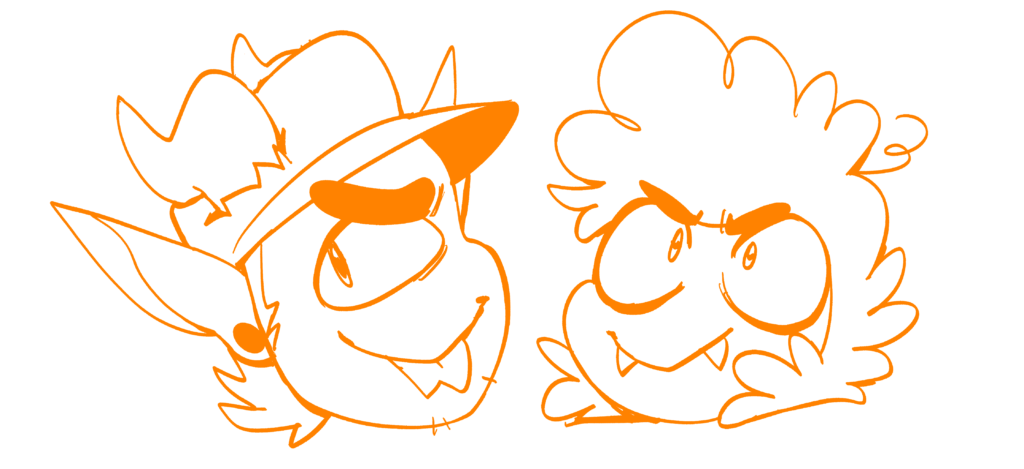
Leave a Reply